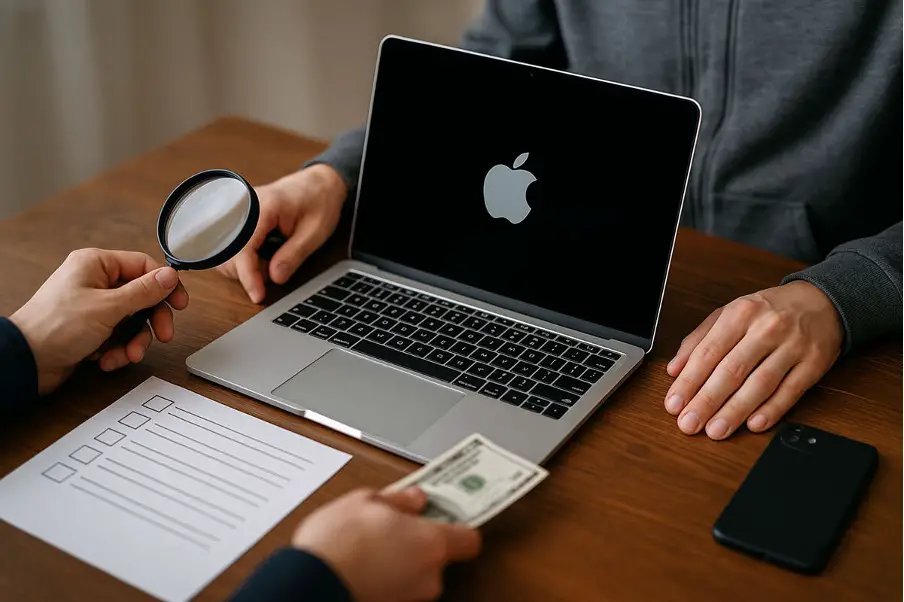Purchasing a used MacBook can be an excellent idea. You shell out less but still get to experience Apple’s premium hardware and macOS ecosystem. But the bargain you see online might be either a shrewd deal — or a costly regret. The second-hand tech landscape is replete with goldmine deals, sure, but also scams, concealed faults, and computers that are a long way beyond their shelf life.
Here’s your complete, no-nonsense guide to buying a used MacBook safely and smartly.
Make Up Your Mind What You Truly Need
First of all, clarify what your true needs are. Do you require a high-performance MacBook Pro for video editing or programming? Or will a lightweight MacBook Air do the job for emails, browsing, and documents?
Make a short list of acceptable models and years. That way, you won’t be easily influenced by bright listings or too-good-to-be-true deals. If a gadget isn’t on your list, don’t get tempted.
Look at the Year and Specs—Not Just the Model
A 2015 MacBook Pro and a 2021 MacBook Pro may have the same name, but they’re lightyears away. Ask the seller for the precise year, processor type, RAM, storage, and battery cycle count. Ensure it aligns with what’s in the listing. If possible, meet in person and verify the specs through About This Mac in the Apple menu.
And don’t forget: older models won’t support the most recent macOS updates, which translates to losing access to important features and security patches.
Perform a MacBook Serial Number Check
One of the brightest things you can do is check the device through a MacBook serial number lookup. The serial number (in About This Mac or printed on the bottom) can inform you of when and where the laptop was made, how it was originally set up, and whether it’s still under warranty or AppleCare.
You can use tools like MacBook serial number lookup. It’s a quick and easy way to confirm you’re not buying a FrankenMac (a machine built from parts of others), a stolen device, or one with serious past issues. It’s especially helpful when the seller is being vague about the machine’s history.
Check for Physical Damage or Repair
When purchasing in person, perform a comprehensive physical examination of the MacBook:
- Examine the screen for cracks, dead pixels, or discoloration.
- Examine the casing for dents, loose screws, or out-of-place panels.
- Test the keyboard and trackpad. All keys should function smoothly, and the trackpad should register consistently.
- Test all ports with appropriate devices (USB, Thunderbolt, headphone jack, SD card slot).
- Pay attention to the fans—if they’re extremely loud, there may be problems inside.
If you’re purchasing remotely, request that the seller forward close-up pictures, particularly of the screen, ports, and bottom. Check for evidence of tampering or third-party repair, which may invalidate any remaining Apple warranty.
Check Battery Health and Cycle Count
MacBook batteries have a limited number of charge cycles (typically around 1000). Once that’s reached, their performance really starts to decline.
You can check the cycle count in the System Information > Power section. A high cycle count doesn’t necessarily indicate a bad battery, but it should at least encourage you to negotiate a discount or add the price of replacement to the cost.
Make Sure iCloud is Signed Out
One very important red flag: iCloud lock. If the last owner fails to sign out of iCloud and disable Find My Mac, you will be unable to erase or reinstall macOS without their password.
Make sure the seller performs a factory reset before you and double-check that there are no activation locks left on the laptop. Without this process, the laptop might as well be a brick to anyone but the original owner.
Request the Original Receipt or Proof of Purchase
Having some kind of proof of purchase not only reassures you that the device was not stolen but also comes in handy if you have to make a warranty claim or resell it down the line. Even a digital receipt or invoice is better than nothing.
If the seller avoids this request or says they misplaced it, beware.
Be on the Lookout for These Scams
Below are some of the most common tricks and tactics used by unscrupulous sellers:
- Too-good-to-be-true price: If it’s significantly lower than comparable postings, there is likely to be a catch.
- No local pickup: If they will only ship and refuse a meetup, it’s a warning sign.
- Fake packaging: Some scammers spare no expense, even going so far as to create fake Apple boxes or manuals. Concentrate on the device itself.
- Mismatched photos: Always request actual photos of the real unit—not just stock photos.
- Forcing fast payment: Never hurry a transaction, particularly if they’re trying to push you to wire money or crypto.
Final Thoughts
Purchasing a used MacBook needn’t be a gamble if you approach it wisely. With a bit of research—reviewing the specs, confirming the serial number, and ensuring the seller is legit—you can take home a high-end performer for pennies on the dollar.
In an era of smooth scams and phony listings, the wisest consumers are the ones who take their time, question everything, and check out every detail. Be one of them.
More iDevice Central guides:
- iOS 17 Jailbreak RELEASED! How to Jailbreak iOS 17 with PaleRa1n
- How to Jailbreak iOS 18.0 – iOS 18.2.1 / iOS 18.3 With Tweaks
- Download iRemovalRa1n Jailbreak (CheckRa1n for Windows)
- Dopamine Jailbreak (Fugu15 Max) Release Is Coming Soon for iOS 15.0 – 15.4.1 A12+
- Cowabunga Lite For iOS 16.2 – 16.4 Released in Beta! Install Tweaks and Themes Without Jailbreak
- Fugu15 Max Jailbreak: All Confirmed Working Rootless Tweaks List
- iOS 14.0 – 16.1.2 – All MacDirtyCow Tools IPAs
- iOS Jailbreak Tools for All iOS Versions
